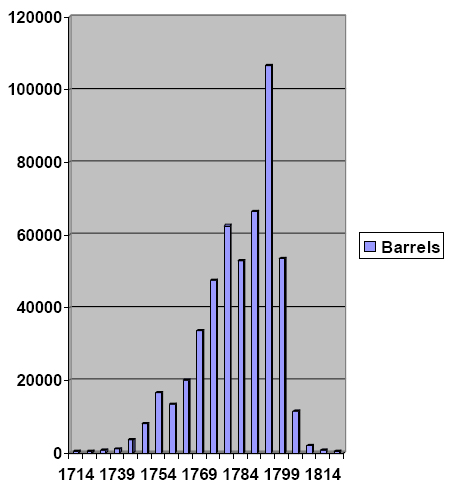
Copyright © 2004 the Brewery History Society
|
Journal Home > Archive > Issue Contents > Brew. Hist., 114, pp. 2-4 |
Porter and its Extra Dimension |
by Thomas B Halpin |
From the middle until the latter end of the 18th century London porter had become the premium malt liquor on the Irish market. By 1793 it had reached 25% by volume of the total beer for consumption. The reaction to this onslaught of English porter on to the market was rather slow. Native brewers laid full blame on to the government of the day using the excuse that the availability of cheap spirits low in excise was primarily responsible. A more critical examination however of all the complex issues surrounding it came very heavily down against Irish brewers who were then reputed to be brewing very poor tasting beers. Many contemporary journalists strongly testified to these general perceptions.
The Royal Dublin Society's promotion through their Arts & Manufacturers Section offered prizes to brewers who were willing to brew porter of a saleable quality. Two prizes were awarded in 1765 to Messers Malone & Andrews probably the first porter brewers in Ireland. This gesture was at least a start however brewers are by nature rather slow and as always very conservative with one or two notable progressive exceptions.
The first great Dublin brewer to publicly advertise his porter for sale at two guineas for hogshead was one Patrick J. Sweetman. Sweetman's Brewery then was located at 81 St. Stephen's Green and would later move to 23-25 Francis St. The original Sweetman family
hailed originally from Castle Eve in Co. Kilkenny could trace their ancestry back to the 14th century. Their Dublin family branch had long moved from their barony and who in 1756 were running five operative breweries in the city. They also married into several other Dublin brewing families of the period. Sweetmans advertisement first appeared publicly in 1780. Only 2% of Irish brewers had described themselves as Porter brewers in the Trade Directory of 1792. Amongst themselves there was a continuous wailing and gnashing of teeth until they began to seriously lobby the Irish Parliament of the day. It was here they found their champion and his name was Henry Grattan.
Grattan was both a brilliant orator and a skilful parliamentarian who managed to have the excise charges (on beer only) repealed in 1793. The basic reason behind this measure was to reduce the excessive consumption of cheap spirits and indeed to encourage beer drinking in Ireland. The impact of this and indeed many other factors had a profound effect on the importation of London and Bristol porters as graphically illustrated here in figure 1. By 1800 there were still very few porter brewers in Ireland indeed Arthur Guinness had just decided to
turn over completely into the role of a porter brewer a year previous (April 1799). Porter even at this juncture of its development was still quite a variable product e8specially as far as its colour was concerned. The solution to this problem was the need to produce a standard roast malt. In 1817 Wheeler patented a method for roasting malt that was rapidly adopted by two very famous maltsters Messers Baird of Glasgow and the Plunkett Bros. of Dublin. From then onwards the brewing of porter and stronger porter became nationally adopted almost all of them calling themselves Ale & Porter brewers. By 1900 six in Dublin and a four in Cork brewed exclusively porter and extra stout porter which became porter and extra stout. The latter was exported to Britain, its imperial colonies, Spanish America, and the U.S. which witnessed the zenith of a golden age of Irish porter.
Extra Stout and it foreign export more robust version are now brewed internationally by Guinness under the Diageo umbrella. Murphy's stout is brewed in Cork and at Magor (East Wales) by Messers Heineken. Messers Beamish and Crawford brew stout in Cork whilst several micro breweries have their own versions of the porters and stouts of yesteryear.
The seeds planted by the Harwood brothers nearly three hundred years ago at their Bell Brewhouse in Shoreditch have returned great harvests. Long may it continue.
|
|
 |
|
|
|
Brewing Industry in England 1700-1830 Matheas |
|
History of the Antiquities of the Diocese of Ossory Vo1.III Carrigan |
|
Sweetman Paper MS 15. National Library |
|
Industrial Agricultural Ireland Coyne |
|
History of the Irish Brewing Industry Brewer 1988 Halpin |
|
Philosophical and Statistical History from Parl Papers Dublin 1838 Morewood. |